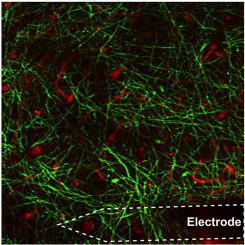Biomaterials ( IF 12.8 ) Pub Date : 2020-11-23 , DOI: 10.1016/j.biomaterials.2020.120526 Keying Chen 1 , Steven M Wellman 1 , Yalikun Yaxiaer 2 , James R Eles 1 , Takashi Dy Kozai 3

|
Intracortical microelectrodes with the ability to detect intrinsic electrical signals and/or deliver electrical stimulation into local brain regions have been a powerful tool to understand brain circuitry and for therapeutic applications to neurological disorders. However, the chronic stability and sensitivity of these intracortical microelectrodes are challenged by overwhelming biological responses, including severe neuronal loss and thick glial encapsulation. Unlike microglia and astrocytes whose activity have been extensively examined, oligodendrocytes and their myelin processes remain poorly studied within the neural interface field. Oligodendrocytes have been widely recognized to modulate electrical signal conductance along axons through insulating myelin segments. Emerging evidence offers an alternative perspective on neuron-oligodendrocyte coupling where oligodendrocytes provide metabolic and neurotrophic support to neurons through cytoplasmic myelin channels and monocarboxylate transporters. This study uses in vivo multi-photon microscopy to gain insights into the dynamics of oligodendrocyte soma and myelin processes in response to chronic device implantation injury over 4 weeks. We observe that implantation induces acute oligodendrocyte injury including initial deformation and substantial myelinosome formation, an early sign of myelin injury. Over chronic implantation periods, myelin and oligodendrocyte soma suffer severe degeneration proximal to the interface. Interestingly, wound healing attempts such as oligodendrogenesis are initiated over time, however they are hampered by continued degeneration near the implant. Nevertheless, this detailed characterization of oligodendrocyte spatiotemporal dynamics during microelectrode-induced inflammation may provide insights for novel intervention targets to facilitate oligodendrogenesis, enhance the integration of neural-electrode interfaces, and improve long-term functional performance.
中文翻译:

神经电极界面少突胶质细胞和髓鞘损伤的体内时空模式
具有检测内在电信号和/或将电刺激传递到局部大脑区域的能力的皮层内微电极已成为了解大脑回路和治疗神经系统疾病的有力工具。然而,这些皮层内微电极的长期稳定性和敏感性受到压倒性的生物反应的挑战,包括严重的神经元丢失和厚的神经胶质包裹。与活性已被广泛检查的小胶质细胞和星形胶质细胞不同,少突胶质细胞及其髓鞘过程在神经接口领域的研究仍然很少。少突胶质细胞已被广泛认为可通过绝缘髓鞘段调节沿轴突的电信号传导。新出现的证据为神经元-少突胶质细胞偶联提供了另一种视角,其中少突胶质细胞通过细胞质髓鞘通道和单羧酸转运蛋白为神经元提供代谢和神经营养支持。本研究采用体内多光子显微镜以深入了解少突胶质细胞体和髓鞘过程的动态,以应对 4 周内慢性装置植入损伤。我们观察到植入诱导急性少突胶质细胞损伤,包括初始变形和大量髓鞘形成,这是髓鞘损伤的早期迹象。在长期植入期间,髓鞘和少突胶质细胞体在界面附近遭受严重退化。有趣的是,伤口愈合尝试(例如少突胶质细胞生成)是随着时间的推移而开始的,但是它们受到植入物附近持续退化的阻碍。尽管如此,微电极诱导炎症期间少突胶质细胞时空动力学的这种详细表征可能为促进少突胶质细胞生成的新干预目标提供见解,











































 京公网安备 11010802027423号
京公网安备 11010802027423号